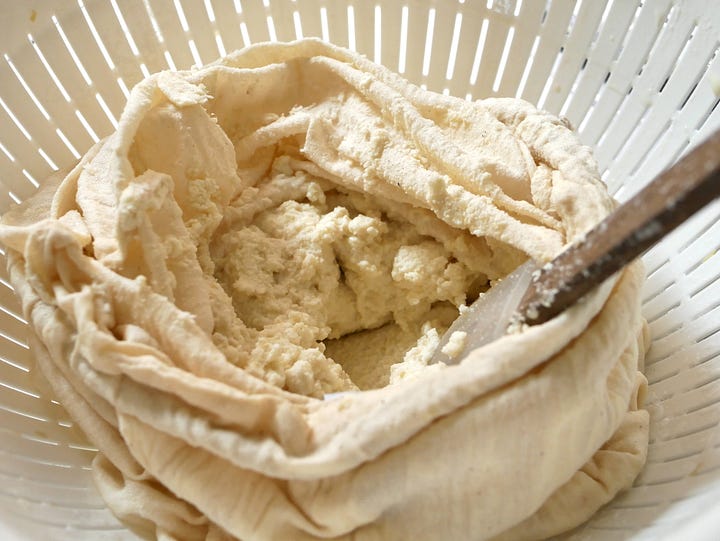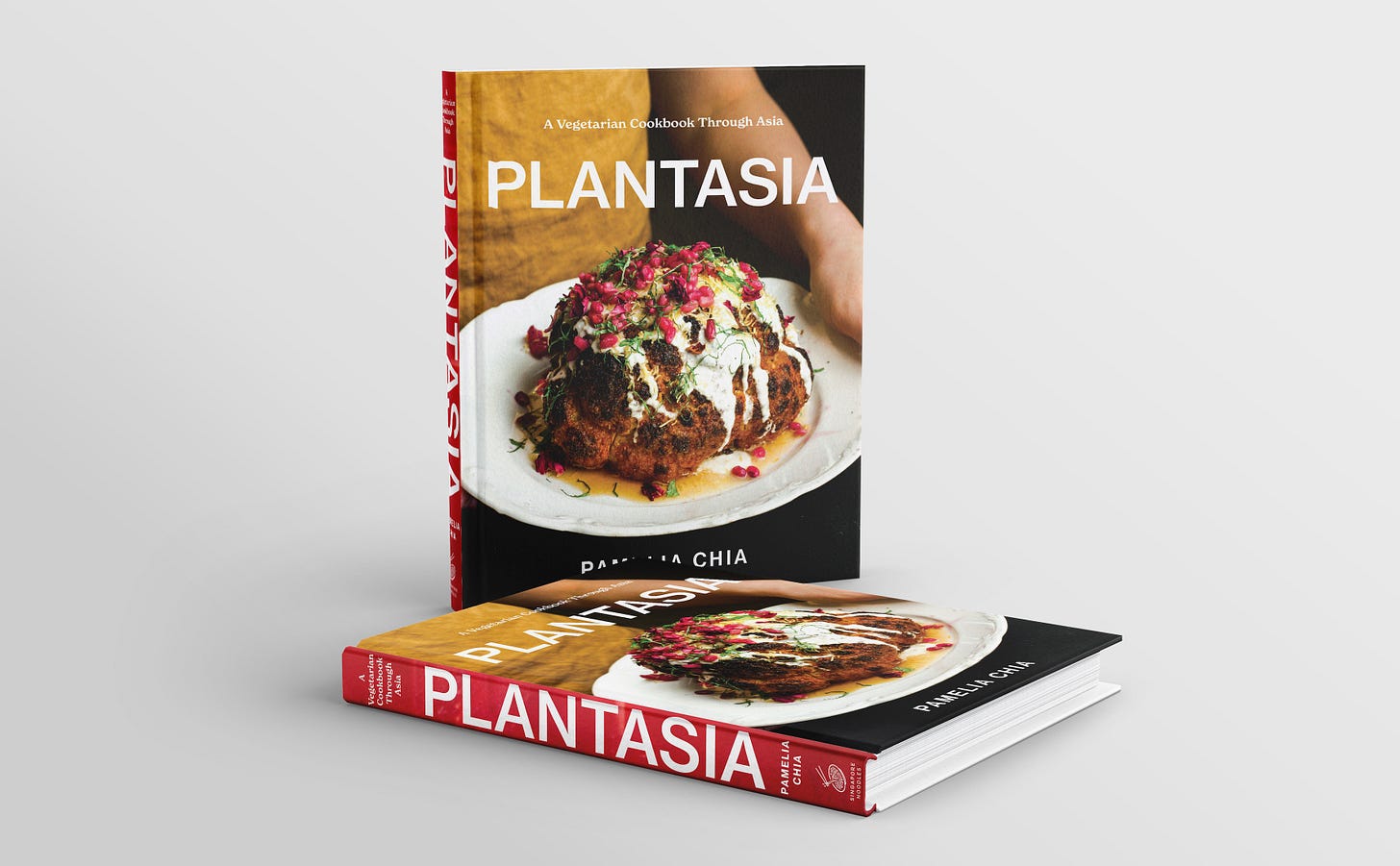✨ Welcome to my newsletter, Singapore Noodles, a celebration of Asian culinary traditions and food memories of Singapore. Find archived recipes and other past content on the index. My book Plantasia: A Vegetarian Cookbook Through Asia is available from Now Serving LA (United States), Goldhahn und Sampson (Germany), and Honeybunch of Onion Tops (Australia), amongst many other stockists around the world. ✨
There’s something special about homemade soy milk. Made solely from soybeans and water, it is grounding in its simplicity. It begins with soaking the dried beans until they swell dramatically in size. You blitz these with water in a blender, wring the slurry in a piece of cloth, and cook the extracted milk in a pot until the raw flavour of the beans transforms into a toasty and rich one, all while the digestibility of the milk is being improved. Hawkers in Singapore toil in the wee hours to make soymilk from scratch, in time for it to be enjoyed for breakfast as an accompaniment for youtiao (dough fritters) or as tau huey — a silken pudding that is made by coagulating soymilk into curd and ladling sugar syrup over the top.
Almost any supermarket that you step into will have long shelf-life soymilk but I can’t bring myself to buy this, for the same reasons that fresh cow’s milk is a completely different experience from what comes in a carton. While Asian grocers do sell large bottles of refrigerated soy milk, there are very few that are not unadulterated. If you are lucky, you might find artisans producing and selling soymilk in your area, but while the quality can be as good as what you’d find in Asia, it inevitably comes with a hefty price-tag as well. Making your own soymilk produces something that is just as good, at a fraction of the cost.
Beany flavour
Despite its growing popularity as a vegan milk, soymilk is appreciated in Asia for its unique flavour and mouthfeel — we don’t think of it as a substitute for anything else. Commercial soymilk, however, is made to cater to a broad market, which includes traditional animal milk drinkers. To replicate the mouthfeel and flavour of cow’s milk, gums and thickeners such as carageenan are often added and steps are taken to remove the supposed ‘beany’ flavour. For those of us who grew up drinking fresh soy milk, this is the thumbprint of artisanally made soy milk. Without it, soy milk tastes bland and lacking in character. But to traditional cow’s milk drinkers who base their understanding of soy milk on animal milk, the ‘beany’ flavour, typically perceived as raw or vegetal, is an undesirable trait.
When dried soybeans are soaked in water, a enzyme called lipoxygenase is activated and causes the unsaturated fatty acids within the beans to oxidise. This process results in the production of hydroperoxides, primary contributors of the ‘beany’ flavour. In commercial soymilk production, soybean cultivars that are low in lipoxygenase are selected and the enzyme is inactivated by soaking the soybeans in hot, alkaline water. Another common method that I’ve seen in many recipes online to eradicate the ‘beany’ flavour in soymilk is to dehull the soybeans after they have been soaked.
Having grown up drinking soymilk my whole life, I was curious to taste a ‘beany’ and ‘non-beany’ soymilk side by side, and see what difference dehulling and inactivating the lipoxygenase in soybeans would make. I soaked three batches of soybeans differently and turned them into soymilk. Here are the results:
Soaked in cool water, hulls left on: The clear winner. This soymilk took me straight to Singapore’s hawker centres. The phrase that comes to mind is apple breath — the scent of soybeans fills and lingers in your mouth the moment you drink the soymilk. Fragrant and rich, fully expressing the character of the bean.
Soaked in cool water, dehulled: Similar results to soymilk made with soybeans that weren’t hulled, being just as beany, but somehow the mouthfeel is less rich.
Soaked in hot alkaline water, dehulled: Tasting as if its soul has been sucked out of it, you could argue that this is the most neutral and perhaps most palatable to those who are new to soy milk. It reminds me of most refrigerated soy milks at the Asian grocer. In terms of mouthfeel, this soymilk is the least creamy and full in the mouth of the three. While this soymilk is not my preference, I appreciated that, with this method, the dried soybeans only had to be soaked for 2 hours instead of overnight and the skins came off easily compared to when the soybeans were soaked in room temperature water.




Unlike cartoned soymilk, the homemade stuff is ephemeral, lasting no more than 4 days in the refrigerator. While we’ve been enjoying it by the glass, I have also been cooking lots with it because fresh soy milk is a versatile ingredient in the kitchen. I made a soymilk tan tan nabe with this recipe but substituted natural peanut butter for the sesame paste. Because fresh soymilk is made with no additives such as emulsifiers, it has a propensity to split. To minimise this, cook the soymilk gently and never allow it to come to a boil.
Making the most of soybeans
With every batch of soymilk, an inevitable question hangs: what to do with all that pulp? Soybean dregs — or okara — is commonly treated as a waste-product, which is a shame because it is highly nutritious and, often, quite a significant quantity to discard. Following my past soymilk sessions, I’ve repurposed okara in multiple ways and my favourite is granola. Gula melaka granola, specifically. Reduced from coconut palm flower sap and set as blocks, gula melaka’s slightly smoky, butterscotchy flavour plays well with coconut oil (no surprises here) but it is spectacular with brown butter. When the okara is tossed in this melted mixture and baked, its mealy texture turns into crunchy, nubbly pebbles that taste deeply nutty and complex, with a subtle whiff of soy. Fabulous scattered over yoghurt or drowned in homemade soymilk.
🥦 My second cookbook Plantasia: A Vegetarian Cookbook Through Asia leverages Asia’s techniques and flavour combinations to expand your repertoire of vegetable dishes deliciously beyond Western-style salads. Pick up your copy here. It is mostly vegan (or easily veganised), with plenty of allium-free options.
Homemade Soymilk
Makes approximately 1.2 litres
The most tricky part about making soymilk is the extraction of the milk. While you can use large pieces of muslin, using a thin cotton bag (I got mine from Søstrene Grene) makes handling and cleaning easy and fuss-free. You will also require a powerful blender.
180g dried soybeans
700ml boiling water + ¼ teaspoon baking soda (for mild-tasting soymilk)
400ml + 1 litre water
Sugar, to taste (optional)
For traditional soymilk: Place 180g dried soybeans in a large bowl, cover with water liberally, and leave to soak overnight at room temperature. Drain the soybeans.
For mild-tasting soymilk: Combine 180g dried soybeans, 700ml boiling water, and ¼ teaspoon baking soda. Soak for 2 hours at room temperature. Rub the soybeans between your palms to split them and loosen the skins. Skim off the skins. Rinse the soybeans and drain them.
Whichever soymilk you are making, transfer the soaked soybeans to a blender and add 400ml water. Blend until smooth. Place a thin cotton bag in a colander and set it in a large bowl. Pour the slurry into the bag and wring gently to extract the soymilk. Gradually add 1 litre water. Wring the bag again to extract as much of the soymilk as possible.
Pour the soymilk into a wide pot and bring to a boil over medium heat, stirring occasionally. When foam begins to rise to the top of the pot, turn off the heat immediately and allow the foam to subside. Cook over low heat, stirring occasionally, for 15 to 20 minutes, or until the ‘raw’ flavour is gone. Turn off the heat and sweeten with sugar to taste if desired. Store the soymilk in the refrigerator for up to 4 days.
Gula melaka granola with okara
Makes 1 large jar
Okara from 1 recipe of Homemade Soymilk (see above)







